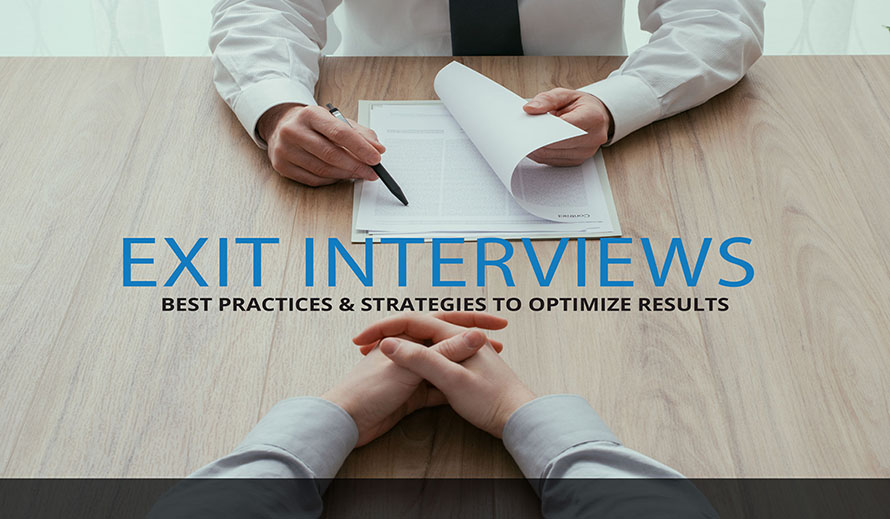Compliance & Legal | Employee Relations
How to Conduct Strategic Exit Interviews
Read Time 4 mins | Jul 10, 2019 | Written by: Frankie Kourtis

 While employee retention is a top priority of HR departments, it’s a fact of life that employees leave. And when employees leave, it can be a missed opportunity to not collect valuable data, such as the reason the employee is leaving, the industry or company the employee is leaving for, etc. An exit interview is a series of questions usually conducted by a member of the HR department of a departing employee.
While employee retention is a top priority of HR departments, it’s a fact of life that employees leave. And when employees leave, it can be a missed opportunity to not collect valuable data, such as the reason the employee is leaving, the industry or company the employee is leaving for, etc. An exit interview is a series of questions usually conducted by a member of the HR department of a departing employee.
Survey Strategically
HR managers want to conduct the LEAST amount of exit interviews possible, however the reality is that, whether willingly or unwillingly, employees will leave companies from time to time. It is important when planning exit interviews that you establish a fixed set of questions to ask ALL departing employees before they’re out the door. This will ensure that you yield employee turnover data that can be used for analysis and to ascertain trends. Winston Tuggle, an HR Business Partner at HubSpot, agrees: “. . .I think one key is asking the same questions of all people who leave. This structure allows us to codify the exit responses so we can extract actionable data around why people are leaving, and how we can improve the employee experience.”
Also, in order to make the departing employee feel comfortable and like his/her voice is being heard, it is a good idea to have a neutral third-party set up the meeting and it should be in person, one-to-one, and confidential. People are less inclined to really open up and share their honest feelings if they unknowingly come into an exit interview that is “stacked” with multiple personnel present. You should try to allay any concerns the interviewee may have regarding sharing his/her honest feedback by reinforcing that the answers will be used solely for productive purposes to improve the employee experience and inform company practices.
A Bevy of Benefits
There are many benefits from conducting strategic exit interviews, but one of the top ones is that they can cut costs. The valuable information that can be gleaned from exit interviews can translate into real savings—time, heartache and headache, and most importantly, money. By departing employees identifying their areas of discontent and motivating factors behind their leaving, this can boost a company’s employee retention rate, which, in turn, can reduce the amount of dollars spent on the hiring and onboarding process. According to a study by The Society for Human Resource Management (SHRM), it costs a company between six and nine months of a given employee’s salary to identify a candidate and onboard a replacement for an open position.
Another upside is the promise of closure. An exit interview provides closure for both sides—the employee can feel a sense of relief about sharing his/her honest feelings and come out with a sense of hope that his/her input will possibly alter practices or inform policies at the company. It is also an opportunity for the employer to allay concerns that the employee may have in going forward and relay pertinent information regarding legality or contractual repercussions, such as non-compete clauses or confidentiality breaches.
Turn Over When There’s Turnover
In order to gain insight, it is critically important to share employee feedback rendered in an exit interview, such as areas for improvement and overall morale, with the organization at large. In fact, by sharing this type of information and examining lessons learned, it is possible for companies to reduce future employee turnover. Shelly Funderburg, Director of Hiring Solutions for Manpower Inc. based in Milwaukee, Wisconsin, echoes this sentiment: “This information is so valuable, it should be included in the company’s annual review, strategic planning, recruiting strategies, training plans, management development program and any tool companies use to evaluate themselves. It doesn’t have to be a sophisticated tool, just something that can be rolled up to senior management on a regular basis.”
LaborSoft’s innovative technology is one of many integral solutions that keep your business, in business. Our employee relations analytics, case management workflows, and our central repository of documentation streamlines case management to mitigate risk of operational bottlenecks, costly lawsuits, and legal ramifications stemming from HR issues and complaints. This sensitive data requires that maximum security protocols are in place and that your information is protected at all times.
------------------------------------------------------------------------------------------------------------Contact us for a customized demonstration and learn how LaborSoft can help you improve communications, build a more collaborative, safe, and supportive workplace, while reducing the likelihood of costly litigation.

